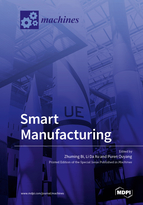Smart Manufacturing
A special issue of Machines (ISSN 2075-1702). This special issue belongs to the section "Advanced Manufacturing".
Deadline for manuscript submissions: closed (31 December 2021) | Viewed by 56098
Special Issue Editors
Interests: enterprise information systems; digital manufacturing; finite element analysis; machine designs; robotics and automation; enterprise systems
Special Issues, Collections and Topics in MDPI journals
Interests: industrial information integration engineering; industrial information systems; industrial informatics; enterprise systems
Special Issues, Collections and Topics in MDPI journals
Interests: mechatronics; robotics; control system; hybrid system; micro/nano engineering
Special Issues, Collections and Topics in MDPI journals
Special Issue Information
Dear Colleagues,
Newly introduced enabling technologies, such as Industry 4.0, Internet of Things (IoT), Cyber-Physics System (CPS), Big Data Analytics (BDA), China Manufacturing 2025, and Cloud Computing (CC), have been changing the landscape of research and development (R&D) in Modern Manufacturing greatly; for examples, (1) the solutions of acquiring and transferring data are becoming affordable to instrument more and more ‘things’ and make them ‘smart’ in systems; (2) business related data is becoming bigger and bigger in terms of ‘volume’, ‘variety’, and ‘velocity’; where advanced data analytics is needed to capture, store, process, utilize data and assure the safety protection; (3) the boundary of a manufacturing system is becoming vaguer and vaguer; where enterprise architecture has to be adaptable to accommodate the needs of the collaborations with dynamic partners with respect to time. Manufacturing research is highly diversified due to the rapidly developed information technologies (ITs).
This special issue aims to explore the correlations of the aforementioned ITs with the emerging research topics in Smart Manufacturing. A paper on one or more of the following subjects is especially welcomed:
- Literature review on the state of the art of manufacturing such as Smart Manufacturing, Sustainable Manufacturing, Cloud Manufacturing, and Digital Manufacturing
- Cyber physical systems in manufacturing
- Internet of Things in manufacturing
- Big Data Analytics in manufacturing
- Cloud-Computing in manufacturing
- Enabling technologies for sustainable manufacturing
- Adaptable enterprise architecture such as service-orientated architecture (SoA) and agent-based systems
- Digital manufacturing
- New sensors and controls for machine tools, fixtures, and other smart things
- Data mining for planning, scheduling and controls
- Development of intelligent systems such as robots, autonomous guided vehicles (AGVs), and other programmable manufacturing resources
- Case studies in smart manufacturing
Prof. Dr. Zhuming Bi
Prof. Dr. Li Da Xu
Dr. Puren Ouyang
Guest Editors
Manuscript Submission Information
Manuscripts should be submitted online at www.mdpi.com by registering and logging in to this website. Once you are registered, click here to go to the submission form. Manuscripts can be submitted until the deadline. All submissions that pass pre-check are peer-reviewed. Accepted papers will be published continuously in the journal (as soon as accepted) and will be listed together on the special issue website. Research articles, review articles as well as short communications are invited. For planned papers, a title and short abstract (about 100 words) can be sent to the Editorial Office for announcement on this website.
Submitted manuscripts should not have been published previously, nor be under consideration for publication elsewhere (except conference proceedings papers). All manuscripts are thoroughly refereed through a single-blind peer-review process. A guide for authors and other relevant information for submission of manuscripts is available on the Instructions for Authors page. Machines is an international peer-reviewed open access monthly journal published by MDPI.
Please visit the Instructions for Authors page before submitting a manuscript. The Article Processing Charge (APC) for publication in this open access journal is 2400 CHF (Swiss Francs). Submitted papers should be well formatted and use good English. Authors may use MDPI's English editing service prior to publication or during author revisions.
Keywords
- smart manufacturing
- sustainable manufacturing
- cloud manufacturing
- digital manufacturing
- sensors and actuators
- advanced manufacturing
- cyber-physics systems
- internet of things
- industry 4.0
- big data analytics
- literature survey
- robotics and automation








